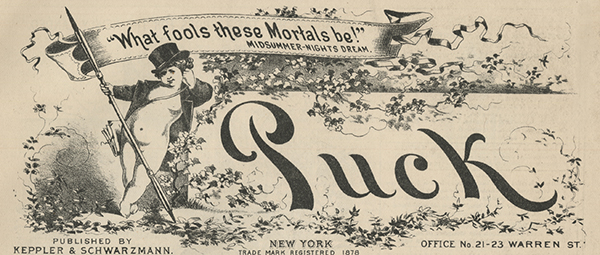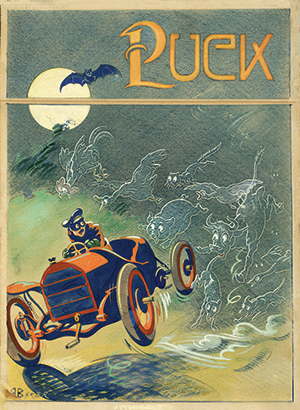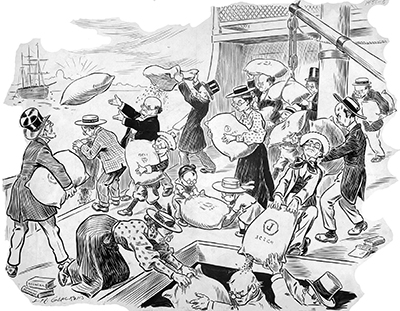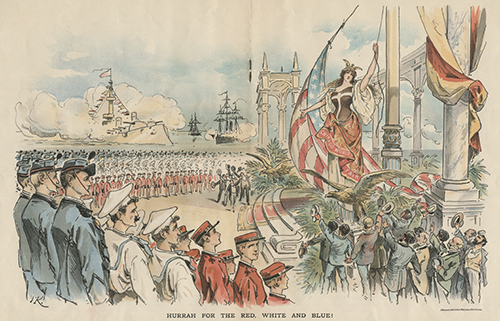PALM BEACH, FLA. — “With a Wink and a Nod: Cartoonists of the Gilded Age,” organized by and on view at the Flagler Museum October 13–January 3, showcases rare original drawings made for the magazine Puck, a pioneering publication that helped shape the character of American humor. Many of the Gilded Age’s most talented illustrators contributed drawings to Puck, ranging in content from lighthearted observations of daily life to political satire.

An early Puck masthead designed by Joseph Keppler Sr (1838–1894), featuring the character Puck and his famous observation, “What fools these mortals be!” Named after Shakespeare’s mischievous sprite in A Midsummer Night’s Dream, Puck was often depicted in the magazine’s cartoons pointing out the errors — or foolishness — of man’s ways. Flagler Museum Archives.
Created by Austrian immigrant and cartoonist Joseph Keppler Sr and German printer Adolph Schwarzmann, Puck and its artists sought to bring about change through humor, attacking those guilty of corruption, greed or vanity, and supporting the rights of the underdogs. Named after Shakespeare’s mischievous sprite in A Midsummer Night’s Dream, the magazine’s masthead featured the character Puck and his famous observation, “What fools these mortals be!” A perfect manifestation of the magazine’s editorial point of view, Puck was often depicted in cartoons pointing out the errors — or foolishness — of man’s ways.

“The Haunted Auto” by Alfred Zantziger Baker (American, 1870–1933), published as the cover of the April 20, 1910, issue, portrays the ghosts of unfortunate animals haunting the reckless operator of a relatively new invention, the automobile. Collection of Jean S. and Frederic A. Sharf, courtesy of the Flagler Museum.
Published initially as a German language magazine in 1876, Puck’s first English edition was printed in 1877 and continued to 1918. Puck was packed with lavish cartoons, color lithographs and biting satire about everything from politics to fashion and domesticity. While it emerged from a Nineteenth Century tradition of satirical political cartoons, Puck stood out from the other American humor publications as it was the first to use full color lithographs in every issue, employing vivid color on the front cover, centerfold cartoon and back cover. The cartoons were often bold, graphic, and exaggerated, with content ranging from silly to sarcastic. Artists drew on common stereotypes like the hayseed and the new woman, and caricatured politicians, businessmen and cultural leaders alike. No one was spared from ridicule, and the magazine’s response to complaints was simply, “Can’t you take a joke?”
The magazine achieved its greatest success during the 1884 presidential election, when Puck saw its highest subscription rate ever. This success is often attributed to its trailblazing political cartoon series known as “The Tattooed Man,” which skewered Republican Senator James Blaine and may have contributed to Governor Grover Cleveland’s election as president.
Puck helped develop American humor, from earlier tall tales to the more urbane and literary humor associated with publications such as the New Yorker, by becoming a training ground for a generation of talented cartoonists. Original drawings in a variety of styles by artists such as Samuel Ehrhart, Louis Dalrymple, Louis Glackens, Franklin Howarth, Frederick Opper and William Rogers are featured in the exhibition. Puck’s editors encouraged experimentation and their artists pushed the limits of the art form.

A cartoon by Louis M. Glackens (American, 1866–1933), “The Boston Coffee Party,” published September 6, 1905, is a reaction to wasteful appropriations and Congress’s recommendation that a tax on coffee be introduced as a way of increasing revenue. Collection of Jean S. and Frederic A. Sharf, courtesy of the Flagler Museum.
Puck’s style and design were often imitated, spawning dozens of copycats over the years, including Judge and Life. For 40 years, Puck reigned supreme, constantly adjusting to stay on the forefront of humor but never losing sight of the core values the magazine was built upon. The long-running magazine remains a valuable resource for understanding how Americans viewed politics, religion and other aspects of daily life during the Gilded Age.
Puck’s adoption of the new technology of chromolithography (or color lithography), a process popularized in America after the Civil War, made possible mass produced, high-quality color printing at low cost. In 1893 Puck was invited to World’s Columbian Exposition in Chicago and printed a special 14-page weekly World’s Fair Puck edition that year, while still publishing regular weekly issues at the New York headquarters.

Joseph Keppler Sr, a founder of Puck, created “Hurrah for the Red, White and Blue!” as the patriotic Fourth of July centerfold in World’s Fair Puck, July 3, 1893, published at the World’s Columbian Exposition in Chicago. Flagler Museum Archives.
Creating a color revolution in the American magazine world was not the magazine’s only claim to fame, however. Puck greatly influenced the growth of the genre of humor in America, and employed artists who made major contributions to the field of illustration and the development of modern cartoon art. In the beginning Joseph Keppler, Sr’s work dominated the magazine’s covers and centerfolds, but by the 1880s Puck employed other talented artists, including Charles Taylor, Frederick Opper, Samuel Ehrhart and Louis Dalrymple to create drawings for the publication.
The museum is at 1 Whitehall Way. For more information, www.flaglermuseum.us or 561-655-2833.

